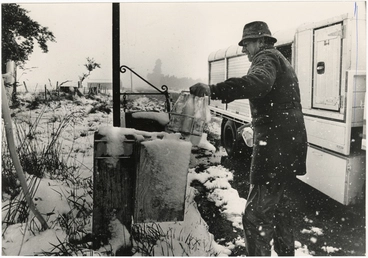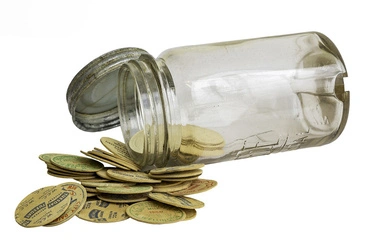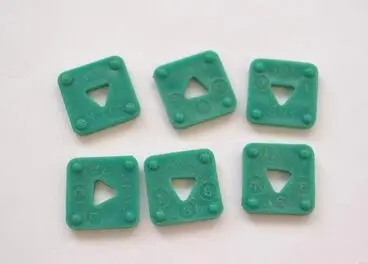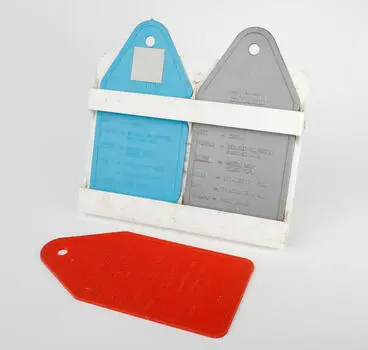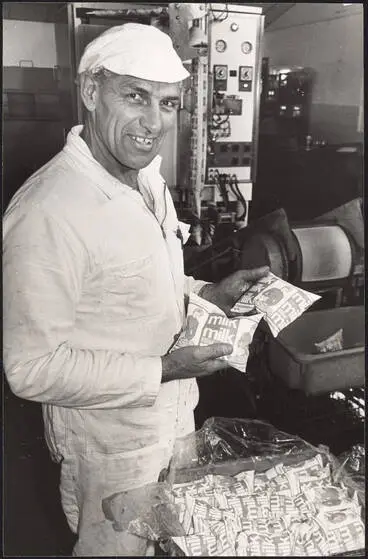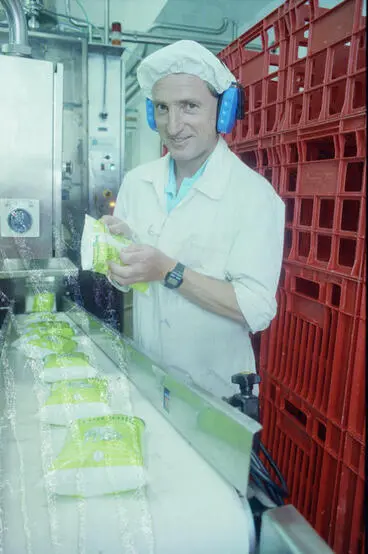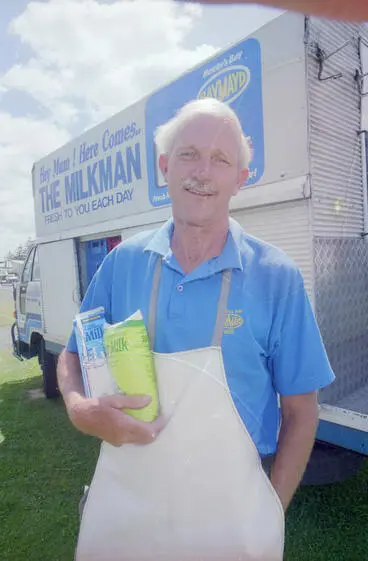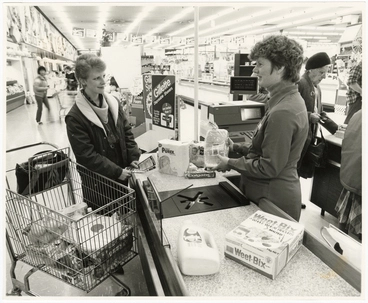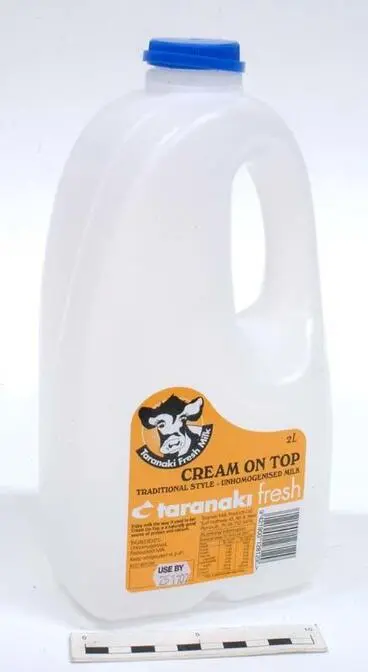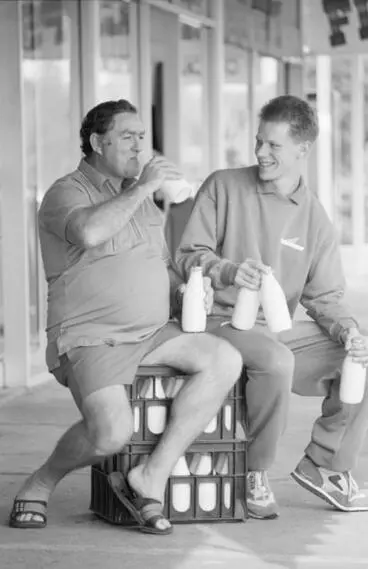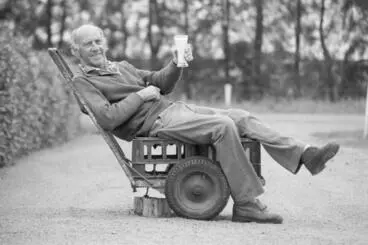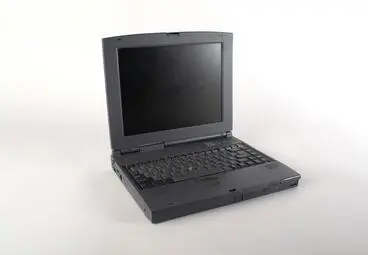Milk was delivered to households in New Zealand cities and towns initially by horse and cart until trucks and vans were introduced. Cream cans were used to fill the household billy until the 1950s when glass bottles began to be used widely. Milk men and women would deliver bottles of milk and cream to householders who'd leave their empty bottles and coins (and later, tokens) at the gate. Glass bottles were replaced by cartons and plastic bottles from the late 1980s. With supermarkets permitted to sell milk from 1986, household deliveries declined with the majority stopping during the mid-1990s.
Horse & cart carrying milk in cans which were poured into household billies
Horse-drawn milk deliveries
Manatū Taonga, the Ministry for Culture and Heritage
Glass bottles being delivered by vehicle and empties collected from the letterbox
Milkman delivering full bottles & collecting empties from letterbox
Alexander Turnbull Library
Householder collecting bottles of milk & cream
Evans Family Collection: Betty Evans at the letterbox, 5 Mansford Place
Palmerston North City Library
HORSES & CARTS
When horses and carts were used for household delivery, milkmen carried big vats of milk. Households would either queue up with their billies or leave their milk can outside to be filled by the milkman - a large can for milk and a smaller one for cream.
The Kiora creamery, Makauri, Gisborne
Auckland Libraries
Watson Milk Delivery Truck and Carriage
Hawke's Bay Knowledge Bank
Milkman, Karori, Wellington
Alexander Turnbull Library
"Lois Puklowski remembers when milk was delivered by horse and cart, she used to watch in delight as the milkman ladled it into her billy. It was the mid-1930s and Puklowski would join other children from her neighbourhood in Aramoho, Whanganui, excitedly awaiting the milk cart. "He'd only stop a couple of places in the street and everyone used to queue up with their billies," she says..Milk was tuppence a pint (less than 3 cents for 568 millilitres)…"
Source: Rebecca Black, “From billies to bottles to unbreakables: milk through the decades." (13 Oct 2019), Stuff.co.nz
Mr Sorby with the Milk Delivery Cart
Kete Horowhenua
Mr L C Driver's milk delivery float, Summerhays Street
Palmerston North City Library
Albert Bailey and milk cart.
Auckland Libraries
Delivery Trucks & Vans introduced 1910s onwards
Milk trucks began to be introduced in the 1910s and vans in 1930s. In some places, horses continued to deliver milk into the 1960s.
1916: Milk delivery on 'Straker-Squire' truck at Pakuranga
Mattson's milk delivery 'Straker-Squire' truck.
Howick Historical Village
1923: Milk delivery truck of L M Monk, Makara
Milk delivery truck of L M Monk, Makara
Alexander Turnbull Library
Watson Milk Delivery Truck
Hawke's Bay Knowledge Bank
Milk vendor and van, Pukekohe, 1936
Auckland Libraries
War time milk delivery - Una and Esme Castleton.
Auckland Libraries
Wartime milk delivery, corner Alpha Avenue and Normans Road, Bryndwr, Christchurch
Christchurch City Libraries
1942: H. Svendsen & Sons milk delivery vans at Pukekohe
Milk vendors and vans, Pukekohe, ca 1942
Auckland Libraries
As well as milk and cream, this van also delivered eggs to Silverstream in Upper Gutt
William Deller, Silverstream; fresh milk, cream, eggs, in his Morris Minor van.
Upper Hutt City Library
1950: Battery powered milk truck with J Purser and Son Limited, Upper Hutt on the door
Battery powered milk truck
Alexander Turnbull Library
Milk cans & billies used
Dairy can
Tairāwhiti Museum Te Whare Taonga o Tairāwhiti
Horse and cream cans
Auckland Libraries
Levin Dairy Co milk cans 1949
Kete Horowhenua
Bottled milk & cream
Wellington City Corporation Milk Department, 1920s:
In the 1920s, the Wellington City Corporation Milk Department began delivering town milk in recyclable glass bottles for hygiene and health reasons.
A Brief History of the Municipal Milk Supply
Wellington City Libraries
Milk bottle
Museum of New Zealand Te Papa Tongarewa
During WWII, a one-and-a-half pint bottle made in the US was distributed by local milk vendors, Stonex Brothers
A special milk bottle, Papatoetoe, 1972
Auckland Libraries
Nationwide, 1950s:
Eventually, in the 1950s, milk delivery throughout NZ switched from vats to glass bottles. In 1956, the bottle size tracked in the Consumer Price Index (CPI) changed from a quart to a pint. Whereas, the quart average price was about 9.2 pence, the pint average price was about 4.6 pence. (Source: StatsNZ: Tracking milk prices in the CPI)
23 Nov 1951: A new Milk Department truck in Wellington with glass bottles of milk
New Milk Department truck
Alexander Turnbull Library
Amburys Ltd Milk Vendors Auckland Imperial 1/2 pint milk bottle, pre-1976
bottle, milk
Auckland War Memorial Museum Tāmaki Paenga Hira
Milk delivered to schools in half-pints, 1937-1967:
Between 1937 and 1967 school students received free milk at school. Milk monitors supplied a half-pint (284 ml) of milk to each pupil daily.
Schoolboys loading milk trolley
Alexander Turnbull Library
Milk bottles in rack
Alexander Turnbull Library
Metric glass bottles, 1970s:
Gradually, the old pint bottles were replaced by the new 600ml bottles during the 1970s. Information on the price of milk collected by the Consumer Price Index (CPI) showed that from 1972, both bottles were on the market at the same price for a twenty-month transition period. In 1975, the bottle size tracked in the CPI was changed to the metric size of 600ml - the average price was 4.01 cents. (Source: StatsNZ: Tracking milk prices in the CPI)
In 1975, milk bottle sizes changed from imperial pint to metric size of 600ml. Average cost was $4.01.
Milk bottle
Te Awamutu Museum
Cream bottles were changed from the imperial half pint to the metric size of 300ml
bottle, milk or cream
Auckland War Memorial Museum Tāmaki Paenga Hira
MILK REGULATIONS, 1944 & 1953
Milk regulations were introduced on 15 December 1944 under the Milk Act 1944, to ensure the supply and distribution of fresh milk at a reasonable price. A series of legislation was enacted which led to the establishment of the Central Milk Council (1944) and local milk authorities, followed by the New Zealand Milk Board (1953). The Board had the responsibility to control and regulate the industry with the objectives of improving milk quality and ensuring an adequate supply of milk to consumers. A quota system was established whereby farmers guaranteed to supply high quality milk on a year round basis in return for a guaranteed price. The Milk Board also licensed milk processors in each area to receive the milk and arrange the supply to consumers. Milk vendors were appointed by the processors but were under the quality control of the Milk Board. As well as the central setting of producer prices, consumer prices were also set. A government subsidy was paid to make up the shortfall between producer and consumer prices. (Source: StatsNZ: Tracking milk prices in the CPI)
1956: Milk crates loaded onto Winstone's Trucks and Transport Vehicles
Winstone's Trucks and Transport Vehicles: 1956 Winstone truck on school milk run
The Fletcher Trust
1957: Milk delivery truck in Wellington
New type of milk delivery truck at the factory
Alexander Turnbull Library
Pasturised milk, 1940s -
From the 1940s, milk began to be pasteurised (heat treated) to kill bacteria that can cause food poisoning and make milk deteriorate or 'go off'.
Pasteurised milk poster, 1940s
Manatū Taonga, the Ministry for Culture and Heritage
Cardboard tops
A cardboard bottle top cap was used to secure the contents of a milk bottle.
Milk bottle top
Museum of New Zealand Te Papa Tongarewa
Milk bottle top
Museum of New Zealand Te Papa Tongarewa
Cream bottle top
Museum of New Zealand Te Papa Tongarewa
Milk bottle top
Museum of New Zealand Te Papa Tongarewa
This bottle top was used to seal milk bottles during the Royal Tour of Queen Elizabeth II to NZ in 1953-54
Milk bottle top, 'Welcome to Our Gracious Queen'
Museum of New Zealand Te Papa Tongarewa
Foil caps
Eventually foil caps were introduced.
Milk bottle (a quart) and cream bottles (half pint) with aluminium lid
Milk and Cream bottles x 3
Mangawhai Museum
1957: Checking the seal on new bottles, Wellington City Milk Department
Checking the seal on new bottles, Wellington city milk department
Alexander Turnbull Library
1959: A crate of bottled milk
A crate of bottled milk, in a factory, location unidentified
Alexander Turnbull Library
1986: These 600-ml glass bottles have aluminium-foil covers pressed into grooves near the top
Bill Jeffries, M P on a milk run with Joe Serci.
Upper Hutt City Library
1983: Wellington milk vendor
Wellington milk vendor John Houlihan on his milk round
Alexander Turnbull Library
1989: Birkenhead milk vendor
Mr W. Buckthought, Birkenhead milk vendor, with assistant Stephen Pearson.
Auckland Libraries
Homogenised milk
in 1953/54, homogenised milk was introduced in some districts to provide for the needs of babies and for the school milk supply. The homogenization process involved pumping milk through small openings under very high pressure to disperse the cream that rises to the top of the bottle (fat globules) evenly throughout the milk. Following a consumer study by the Milk Board in 1957, homogenised milk was introduction in Palmerston North and then wider afield.
Foil cap with blue & silver stripes. Marked "STANDARD / HOMOGENISED" on 600ml bottle
Bottle Milk Bottle
MOTAT
Empty bottles & coins
Milkmen would deliver glass bottles of milk and cream to households who'd leave their empty bottles and coins at the gate.
Food - Milk - Milk Department
Archives New Zealand Te Rua Mahara o te Kāwanatanga
During the 1960s, when living in Avondale in Auckland, Lois Puklowski would "leave their empty bottles and coins at the gate. Quite often the money was stolen long before the milk arrived, she says, the milkman would leave a note: no money, no milk. "Our money had been pinched one day and the milkman chased the kids along the road. He said their socks were full of money, they were bouncing up and down. He was laughing, it looked so comical." It was thruppence for a pint of milk in her area, and Puklowski would leave three pennies in each bottle at the gate."
Source: Rebecca Black, “From billies to bottles to unbreakables: milk through the decades." (13 Oct 2019), Stuff.co.nz
Milk bottle on a letterbox with caption 'money the milkman collects'
Alexander Turnbull Library
Milk crates, milk bottles and cash with caption 'money the milkman collects'
Alexander Turnbull Library
Temptation for thieves flat. Milk bottles
Tauranga City Libraries
When decimal currency was introduced on 10 July 1967, the standard retail price for milk was set at 4c per pint and cream cost 8c per quarter pint.
[NZ Accommodation - Old Peoples Homes. Selwyn Village. �This is NZ. What�s the latest Selwyn Village� (Glass milk bottle)]
Auckland War Memorial Museum Tāmaki Paenga Hira
Delivering milk in the snow
Christchurch City Libraries
Milk-runs part-time job for children
Milk runs became a popular part-time job for pocket money for boys and girls.
1975: Girl pushing a cart filled with crates of milk bottles along a footpath in a Welington street
Girl delivering milk
Alexander Turnbull Library
Milk tokens & TAGS
In some parts of the country, tokens were left out for the milkman. By the 1980s coloured plastic tokens were widely used which were usually bought from the local dairy. The tokens were left in the bottom of empty glass milk bottles at the gate or letterbox, and the colour indicated whether cream, homogenised milk or whole milk was required. A set of coloured tags for ordering milk for home delivery were also used in some areas. A white, plastic holder with holes was screwed to a post or fence and tags were inserted in the pockets with different colours for cream, standard homogenised milk and whole milk.
Cardboard milk tokens with name of the milk company and day of the week used in New Plymouth & Wellington
Milk Tokens
Mangawhai Museum
1956: Hutt Valley milk tokens
Unidentified man with Hutt Valley milk tokens
Alexander Turnbull Library
By 1980s, a coloured plastic token left inside an empty bottle was widely used - colour indicated milk or cream
Milk Tokens
MOTAT
Different coloured tags designed to hang at a gate: red for cream, blue for homogenised & silver for whole milk
Tags, milk delivery
Puke Ariki
Home deliveries versus local dairy
From the early 1900s small shops called ‘dairy produce sellers’ sold milk, cream, cheese, butter and eggs. They were the only shops allowed to sell these products and were also allowed to open on the weekend. These shops became known as "cash grocers" and then "dairy" from the late 1930s. Households could have a standing order for a weekly delivery of milk, groceries and meat, or phone through an order, or leave a list with the grocer. Such home deliveries were disrupted during World War II and then resumed afterwards. When refrigeration in households and cars became increasingly available in the 1950s, some households purchased their milk from their local dairy rather than have it delivered by the milkman.
Source: Carl Walrond, 'Food shops - Self-service grocers and supermarkets', Te Ara - the Encyclopedia of New Zealand, http://www.TeAra.govt.nz/en/food-shops/page-6
1972: Bottles of milk bought from a store
Mrs Janette Frost with bottles of milk
Alexander Turnbull Library
1980: Districts like Ngaio still had the option of milk vendor delivering milk to the letterbox
Ngaio, 1980
Museum of New Zealand Te Papa Tongarewa
1980: Waiting for his milk delivery on Worcester Street, Christchurch
Waiting for the milkman
Christchurch City Libraries
Sachets of milk, 1971 -
In 1970, the Waikato Milk Co. purchased the first plastic sachet filling machine and began marketing the new product the following year. In 1973, skim milk was also made available. However, while stores retailed milk in cartons, plastic sachets or plastic bottles, home delivery systems bottled their milk.
1979: Sachets of milk being produced at the Pukekohe Milk Treatment Station
Sachets replace cartons, Pukekohe, 1979
Auckland Libraries
1993: New plastic sachets of HB Milk being tested at Hawke's Bay Milk Corporation
Hawke's Bay Milk Corporation staff member Peter Jarvis
MTG Hawke's Bay
Milk deregulated & Cartoned milk introduced, 1986 -
The central setting of producer and consumer prices for milk was lifted by the Government in 1976, followed by the removal of the Government subsidy in 1985. The retail price of a 600ml bottle of milk doubled from 4 cents in January 1976 to 8 cents in February 1976. Three years later, in April 1979, the price rose from 10 cents to 15 cents.
On 30 May 1986, the Government announced the proposal to deregulate milk production and introduce cartoned milk. Paper or cardboard packaging was first investigated in 1956 by the Milk Board which preferred the Swedish Tetra-Pak cartons. However, the cost of importing the paper would increase the cost of the milk. The packaging of cream in cartons was initially trialled in Auckland supermarkets and dairies in 1969. Following the recommendations of a Task Group report" Milk Marketing and the Role of Alternative Packaging" (Nov 1984), the Government approved the introduction of alternative packaging in October 1986.
The introduction of cartoned milk led to glass milk bottles ceased being used in the late 1980s.
SUPERMARKETS COULD SELL MILK, 1986 -
On 30 May 1986, the Government proposed that supermarkets be permitted to sell milk. Later in August 1986, the Government enacted a fixed milk price designed to prevent supermarkets undercutting home-delivery vendors. GST was introduced on 1 October 1986 at a rate of 10% on most goods and services. The retail price of a 600 ml bottle of milk ranged from 48 to 60 cents over the country. From 1 September 1987, the Government relaxed price controls and the Milk Board allowed for supermarkets to purchase milk from a range of suppliers and to be exempt from the requirement to provide a home delivery service. From 26 April 1988, supermarkets could sell milk within a fixed margin below the home delivery price of the processor's milk, which enabled some price competition.
On 30 May 1986, Government proposed supermarkets be permitted to sell milk
Checkout operator at Northlands SuperValue
Christchurch City Libraries
NZ Dairy introduced plastic milk bottles, 1987
According to Stats NZ, by December 1988, the price for a 600ml plastic bottle was $0.55 and the price for a litre was $0.98. (Source: Rebecca Black, “From billies to bottles to unbreakables: milk through the decades." (13 Oct 2019), Stuff.co.nz)
Bottle, Milk
Puke Ariki
Reduced home delivery sales
With the introduction of cartoned and plastic bottles of milk, as well the traditional 600 ml glass bottle being used, and the authorization of supermarkets to operate as milk outlets and increasing car ownership, the vendors delivering milk to households had reduced sales.
Town milk partially deregulated 1988:
The Government introduced the new Milk Act 1988 which came into effect on 1 April 1988 and partially deregulated the town milk industry. The intent was to provide for the continued home delivery of milk, and to reduce the regulation of the processing, supply, and distribution of milk.
The New Zealand Milk Board was replaced with the New Zealand Milk Authority which had the role of supervising the licensing of milk processors, the allocating of home delivery districts, and influencing of the retail price of shops and supermarkets. Milk processors were now free to acquire milk from farmers in what ever way was most suitable to them and to determine the quotas which had previously been set by the New Zealand Milk Board.
By 1991 only one-third of households continued to buy their milk from a milk vendor at their gate.
The Milk Act 1988 reduced the regulation of the processing, supply & delivery of milk, & allowed ongoing home delivery
The New Zealand Milk Board was replaced with New Zealand Milk Authority which supervised licensing of processors
Massey University
Nov 1988: A review of the deregulation of the NZ town milk industry showed a downward trend in home deliveries
A review of the deregulation of the New Zealand town milk industry
Lincoln University
Town milk fully deregulated 1993:
After the Government introduced full deregulation in 1993, milk could be sold by anyone at any price which led to supermarkets, dairies and service stations selling milk and being able to offer it more cheaply than the milkman. Furthermore, the New Zealand Cooperative Dairy Company (NZCDC) had begun to take over smaller town milk processing companies, some of the smaller processing plants were closed, and some town milk farmers moved into factory supply rather than town supply. The outcome was the home-delivery of milk in many districts started to cease over the new few years.
Dairy co-operatives led to takeovers of smaller town processing companies
Fonterra ranked world's largest milk processor
Radio New Zealand
1993: An Upper Hutt vendor couple lost their milk run through deregulation
Debbie and Paul Hawinkel lose their Silverstream milk run through deregulation.
Upper Hutt City Library
6 April 1993: Tui Foods in competition with Hawke's Bay Milk Corp. began delivering bottled milk in Napier & Hastings
Brian Nicholas and Murray Burgess
MTG Hawke's Bay
Household deliveries largely ceased mid-1990s:
11 Nov 1993: Milk delivery vendor in Napier ceased delivering after 24 years
Ken Hampton
MTG Hawke's Bay
1996: Woolworths introduced NZ's first online supermarket which provided home deliveries and pick-ups
Laptop Computer Toshiba Tecra 8000
MOTAT
Home delivery in some districts, 2010s -
15 Aug 2013: RNZ interview “Fifty years a milkman” still doing home deliveries in Timaru
Fifty years a milkman
Radio New Zealand
2018: RNZ Interview on home delivery initiatives in Kawakawa, Nelson & Henderson
Milk in glass bottles: a pint of nostalgia
Radio New Zealand
April 2019: RNZ interview with Eketahuna Country Meats which began delivering milk to homes in Wellington & Wairarapa
Home delivery: milk in glass bottles
Radio New Zealand
Find out more
Jane Tolerton, 'Household services - Home deliveries', Te Ara - the Encyclopedia of New Zealand, http://www.TeAra.govt.nz/en/household-services/page-5
Carl Walrond, 'Food shops - Self-service grocers and supermarkets', Te Ara - the Encyclopedia of New Zealand, http://www.TeAra.govt.nz/en/food-shops/page-6
Hugh Stringleman and Frank Scrimgeour, 'Dairying and dairy products - Pattern of milk production', Te Ara - the Encyclopedia of New Zealand, http://www.TeAra.govt.nz/en/photograph/15718/the-milkman
Rebecca Black, 'From billies to bottles to unbreakables: milk through the decades.' (13 Oct 2019), Stuff.co.nz
Soraiya Gilmour, 'History of the New Zealand Milk Board.' (Research Report No. 216, August, 1992). Agribusiness & Economics Research Unit, Lincoln University
R.G Moffitt & R.L. Sheppard, 'A review of the deregulation of the New Zealand town milk industry.' (Discussion Paper No.122 November 1988) Agribusiness and Economics Research Unit, Lincoln College, Canterbury
'End of free school milk', URL: https://nzhistory.govt.nz/end-of-free-school-milk, (Ministry for Culture and Heritage), updated 12-Apr-2017
StatsNZ: Tracking milk prices in the CPI

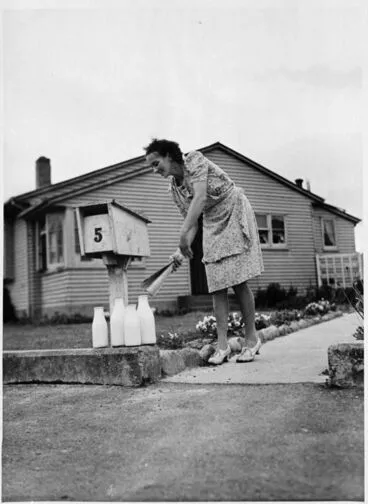
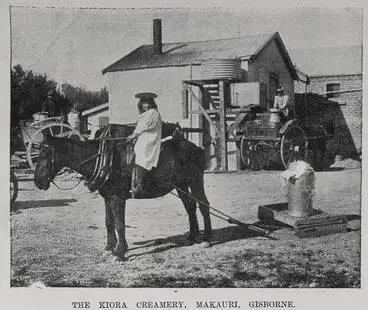
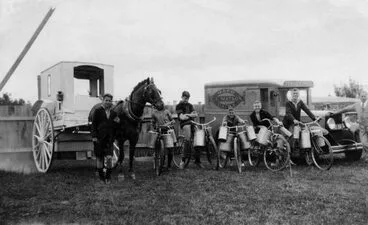
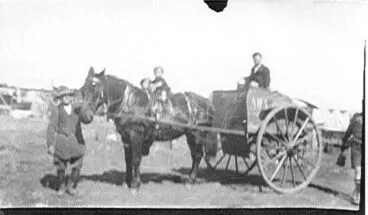
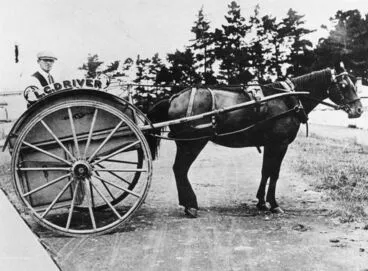
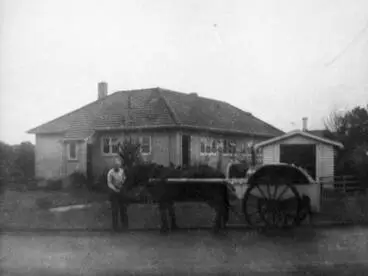
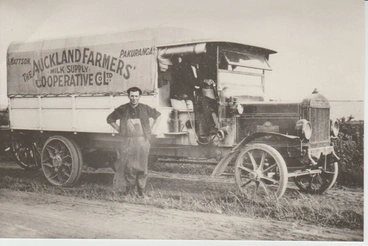
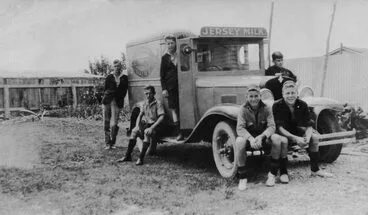
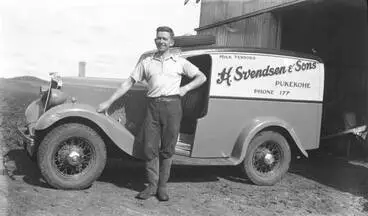
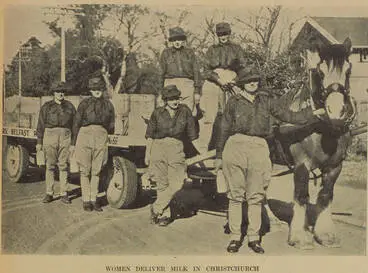
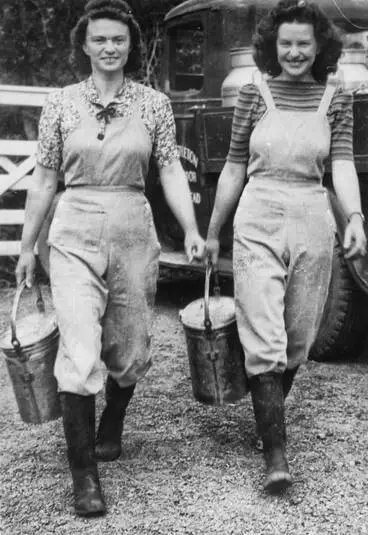
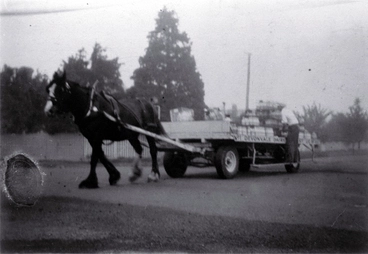
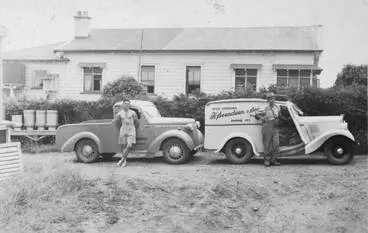
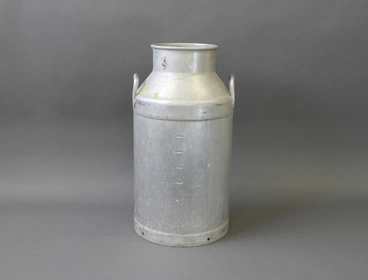


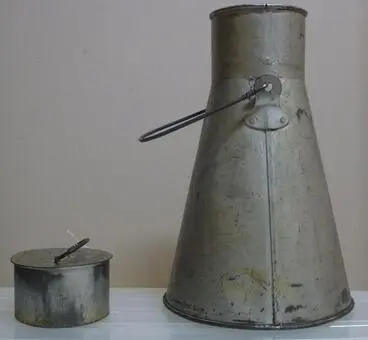
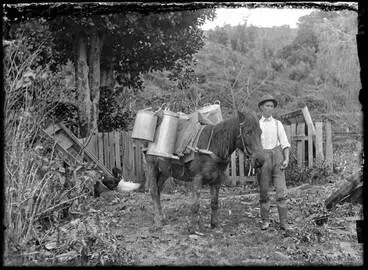
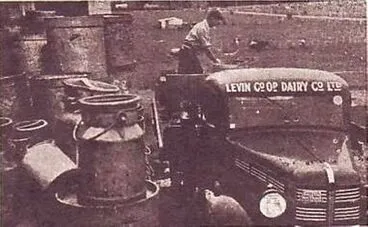
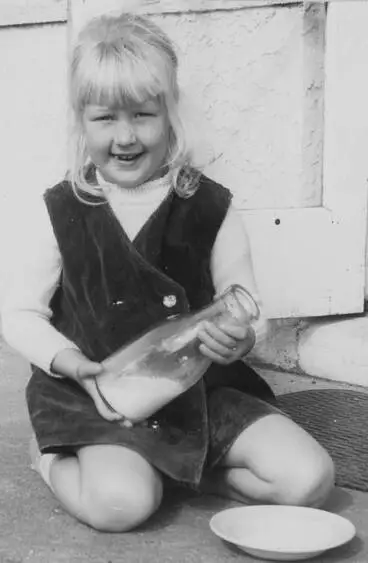
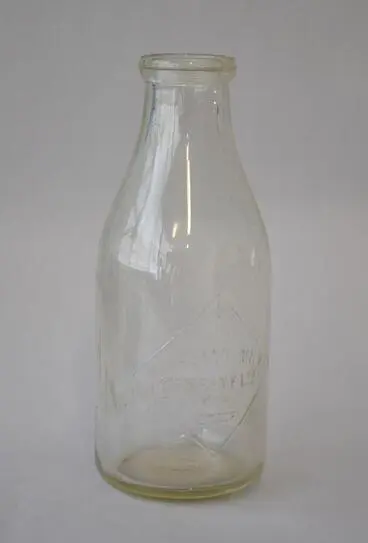

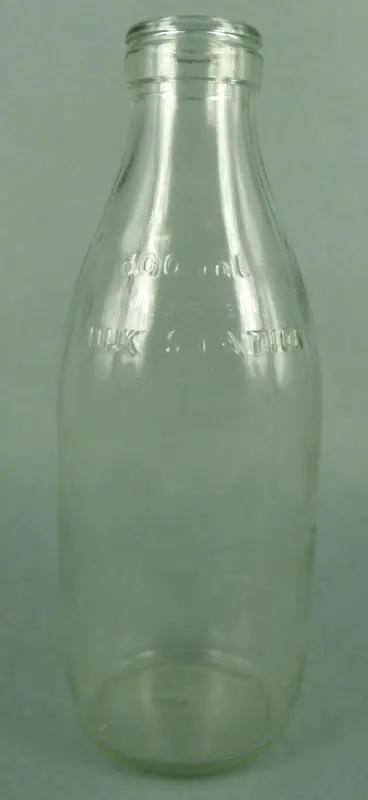

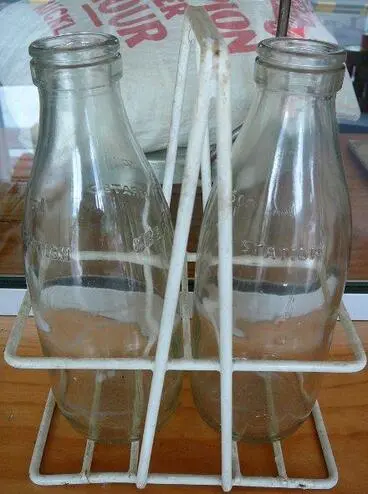



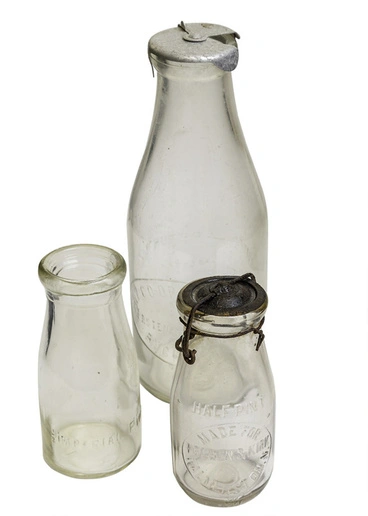
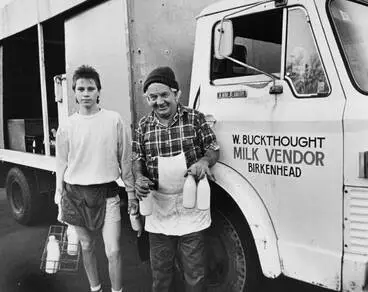
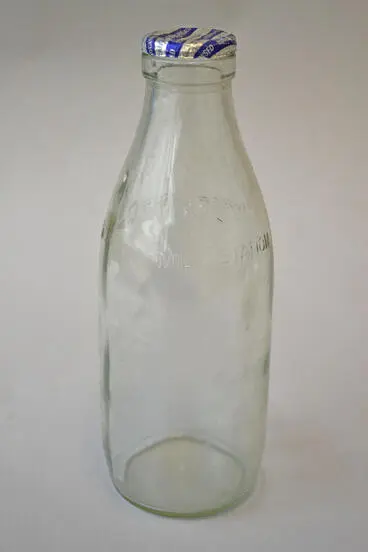
![[NZ Accommodation - Old Peoples Homes. Selwyn Village. �This is NZ. What�s the latest Selwyn Village� (Glass milk bottle)] Image: [NZ Accommodation - Old Peoples Homes. Selwyn Village. �This is NZ. What�s the latest Selwyn Village� (Glass milk bottle)]](https://thumbnailer.digitalnz.org/?resize=770x&src=https%3A%2F%2Fcollection-api.aucklandmuseum.com%2Frecords%2Fimages%2Fmedium%2F545645%2Ff010fe63636a8f33a275dc8d8b674f0d5a2d24a5.jpg&resize=368%253E)
